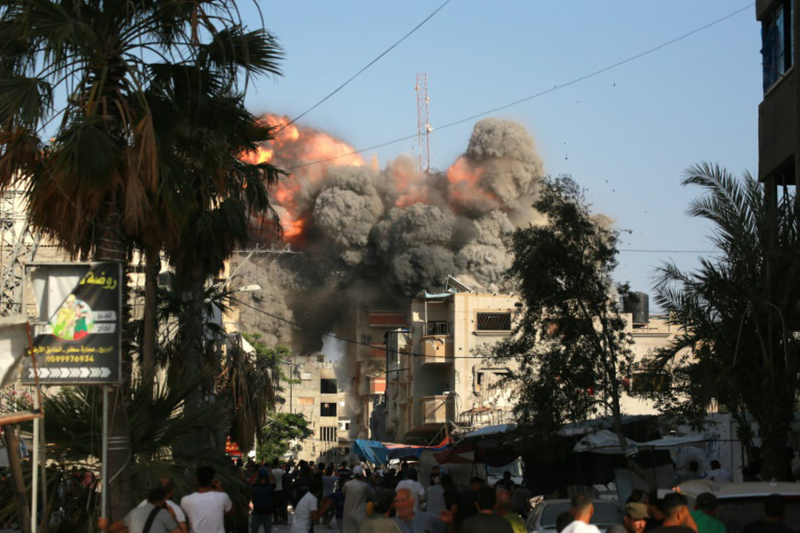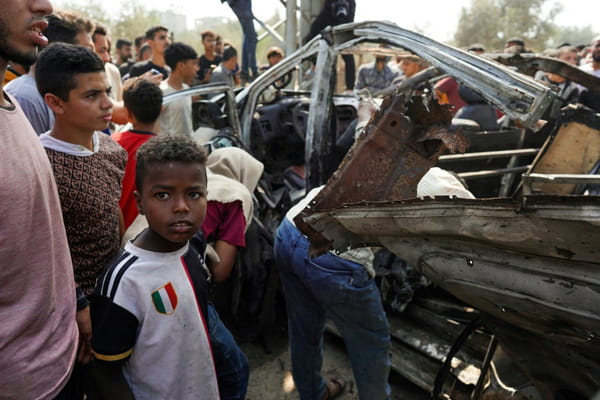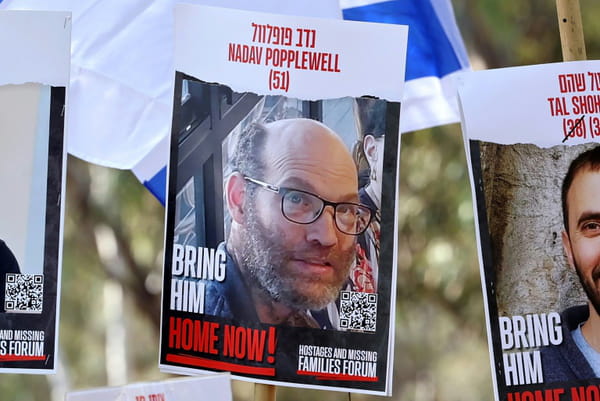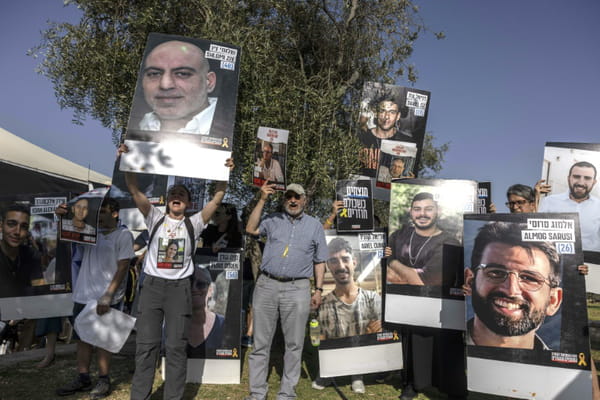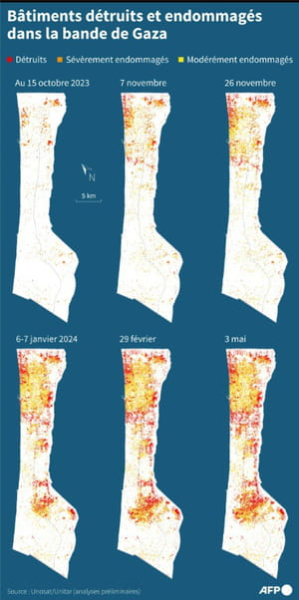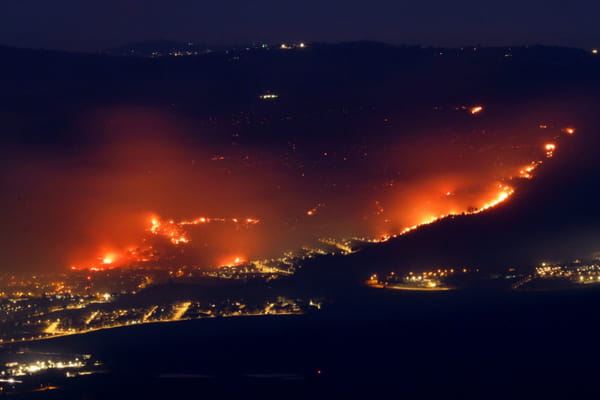Aerial bombardments and artillery fire targeted the area. Tuesday the Gaza Strip from north to south, where Israel continues its offensive against Hamas relentlessly after the announcement of the death of four hostages killed in the Palestinian territory. Despite calls for a ceasefire from around the world, the contradictory demands of the two camps seem to doom to failure a plan presented Friday by American President Joe Biden, after almost eight months of war. Israel has promised to eliminate Hamas, in power since 2007 in the Gaza Strip and author of a bloody attack on its soil on October 7, while that the Palestinian Islamist movement demands a total ceasefire. Nearly a month after the start of a ground offensive on Rafah, a border town with Egypt in the south of the territory, presented by Israel as essential to defeat Hamas, fighting has resumed in other sectors. On Tuesday, airstrikes targeted eastern and central Rafah, according to witnesses and a local official. A witness reported artillery fire in Khan Younes, a town in ruins a few kilometers from Rafah. The bombings left at least three people dead in the town of Gaza, in the north, according to civil defense, and four deaths in the Palestinian camp of Bureij, in the center of the territory. – “Incomplete” proposal – The G7 countries said they “fully” supported the plan presented by Joe Biden, proposed according to him by Israel, providing for a six-week ceasefire accompanied by an Israeli withdrawal from densely populated areas of Gaza, the liberation of certain hostages, notably women and the sick, and Palestinian prisoners held by Israel. Car wreck destroyed by Israeli bombardment in Deir el-Balah, in the central Gaza Strip, June 4, 2024 © AFP – Bashar TALEB This plan aims to establish a “permanent” ceasefire in a later phase, provided that Hamas “respects its commitments”, according to Mr. Biden. The United States announced a draft UN Security Council resolution to support it. But Israel deemed this proposal “incomplete” on Monday. “Allegations that we agreed to a ceasefire without our conditions being met are incorrect,” Prime Minister Benjamin Netanyahu said. Under very strong pressure from his public opinion and his far-right allies, Benjamin Netanyahu reaffirmed his intention to “destroy” Hamas and obtain the release of “all the hostages” kidnapped on October 7. Israel, still traumatized, learned on Monday of the death of four of the hostages kidnapped in kibbutzim in the south of the country, probably killed during the fighting in the Khan Younes sector and whose bodies are still in the hands of Hamas, according to the army. “They should have returned alive to their country and to their families,” said the Hostage Families Forum. – “No alternative” – A photo of Israeli hostage Nadav Popplewell, whose death was announced by the army, held up by relatives on February 28, 2024 near the site of the Supernova music festival in southern Israel © AFP – JACK GUEZ “I urge all parties to immediately reach an agreement to achieve a ceasefire and free the hostages. There is no alternative: any delay costs lives every day,” UN Middle East envoy Tor Wennesland said Tuesday. The war was sparked by the unprecedented attack on October 7, which resulted in the deaths of 1,194 people in Israel, the majority civilians, according to an AFP count based on official Israeli data. Of the 251 people taken as hostages, 120 are still detained in Gaza, of whom 41 are dead, according to the Israeli army. Relatives of Israelis held hostage in the Gaza Strip gather to listen to the Israeli Finance Minister during a rally in Jerusalem, June 3, 2024 © AFP – MENAHEM KAHANA In retaliation, Israel declared war on Hamas, which it considers a terrorist organization along with the United States and the European Union. < p>His army launched an offensive in the Gaza Strip that has so far killed 36,550 people, including 71 in 24 hours, according to data from the Health Ministry of the Hamas-led Gaza government. After several months of ground offensive, Israeli forces entered the town of Rafah on May 7 where, according to the UN, 1.4 million people had taken refuge. of Palestinians. – “No water” – Buildings destroyed and damaged in the Gaza Strip © AFP – Nalini LEPETIT-CHELLA, Laurence SAUBADU, Hervé BOUILLY This offensive, which pushed a million people to flee again, allowed the army to take control of strategic sectors, such as the Rafah border crossing with Egypt and the corridor of Philadelphia, a road that borders the border on the Palestinian side. But over the weeks, fighting has resumed in several sectors of the north and center of the Gaza Strip, which the army had nevertheless assured to control, testifying to a “failure” of the Israeli strategy, underlines Michael Milshtein, specialist Palestinian issues at Tel Aviv University. “Since January or February, Israel has followed a strategy of very precise, limited operations, instead of remaining throughout the territory”, explained this researcher. “This strategy has failed,” he added. Aggravating the humanitarian crisis in the besieged territory, the offensive on Rafah led to the closure of the crossing with Egypt, crucial for the entry of international aid. Humanitarian organizations denounce the insufficient aid, which passes through the Kerem Shalom crossings in Israel, and the immense difficulties in getting it to the populations. Fires break out following rocket fire from Lebanon into northern Israel, near the town of Kiryat Shmona, near the Lebanese border, June 3, 2024 © AFP – Jalaa MAREY In the ruins of Khan Younès, fate befalls the displaced people whose tents found themselves flooded by sewage after a pipe burst. “There is no drinking water. There is not even a water seller in the streets. There is not even sea water,” he told AFP. one of them, Saïd Ashour. In northern Israel, firefighters and the army are meanwhile trying to control forest fires that appeared after shootings rockets from Lebanon. An AFP photographer in Kiryat Shmona, in northeastern Israel, saw intense blazes devouring this border area , scene of exchanges of fire between the Israeli army and Lebanese Hezbollah on the sidelines of the war in Gaza. All rights of reproduction and representation reserved. © (2024) Agence France-Presse